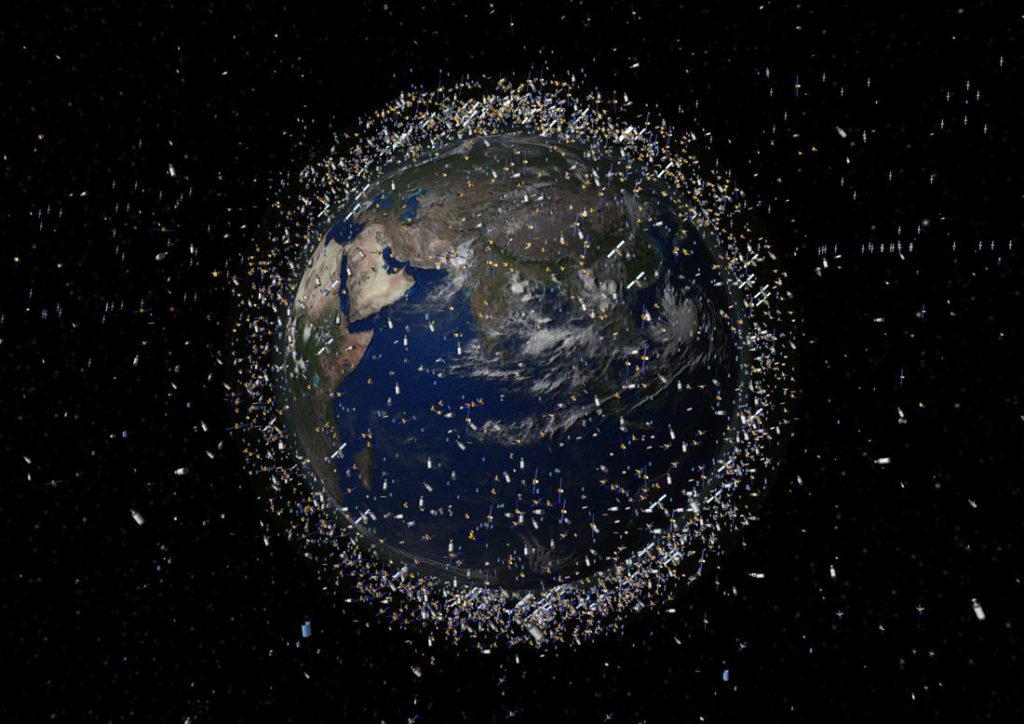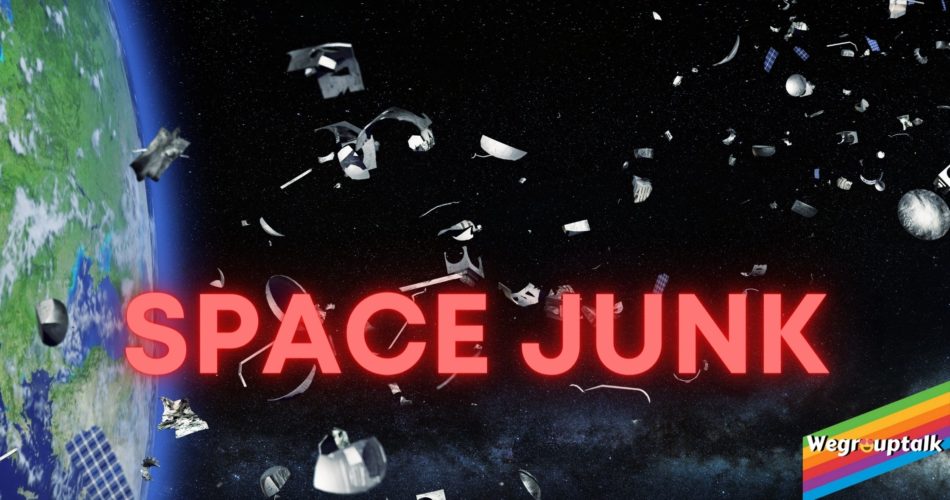Do you know, what can a nut bolt or any piece of metal do to you when it hits you at speed even more than that of a bullet? Okay let’s make it a bit fun, have you seen the movie TENET? If no, then I’ll recommend watching it and if yes, you unquestionably can imagine how much pain a reversed bullet can cause just because of it’s entering the body. Now imagine the diameter of a nut bolt. Yep, you guessed it right; it’s way bigger than the rear of a bullet.
But why did I ask you this question? It is because we have nut bolts moving at those speeds and they are right above us in the never-ending blackness. They can move through humans easily and can tear apart the flesh. They can also move through space stations, satellites, and everything that we put up there.
You might ask now why is it even up there? Well, because of us.
Is it even real? The term space junk. Well yes!
Before telling you any of the details that I am going to present in this article, could you believe that this is real? Our outer space is getting crowded, and we are responsible for it. You might be curious now what we actually have done rather than putting some machines above us who ease our lives and provide us with a better future. Well, let’s get on with it and see further in the article what it is about?
What clicks in your head when you hear this term?
I believe all of us are far more than happy with the advancements humans are making in space research and how eager we are to find a new home. We have been launching satellites in space out there and surrounding ourselves with them for more than half a century. These satellites provide us with information that has helped us to understand quite a deal of the reason for our existence. We can search for other life forms on planets beyond our reach and in galaxies thousands of light-years away.
The satellites lurking above us are the ones that provide us with various vital information and are the main source of our communications. We are too dependent on them, and it can be our major drawback. Our dependency on satellites is intertwined with our communications and our defences, weather navigation, outer space communication, various mining processes, and furthermore to see around various geographical locations that are not evident for us to visit.

No matter what we say but the satellites are boon to us. Or are they?
We are indeed dependent on satellites and all the types of equipment in outer space, but it is also evident that we are exploiting our mother earth and exploiting the space around us. The satellites and other types of equipment launched in the past decades are all there still in orbit. Satellites revolve around us and provide us with important data, and some are decommissioned and are still in their orbits.
You might be wondering what use do these decommissioned satellites have? Well nothing, they do absolutely nothing. I am pretty much sure their only job revolves around us just because they were set into motion at the beginning of their life. And now your head might have given you thought, why don’t we bring them back or send them in the outer space maybe to the sun? Well, only if it were that simple. Let’s leave this part for a later stage in the article and focus on what these and how many are present there?

Let your brain give you a rough number of non-natural things around us in space.
To be precise and according to a count of the man-made pieces in the outer space there are more than 25,000 of them who have a diameter larger than or equal to 4 inches, and to give you an estimate of their size it accounts for a little larger than the size of two golf balls in diameter. It is not just these particles that can harm other working satellites, but there are also more than half a million smaller pieces whose diameter is greater than 0.4 inches and smaller than 4 inches.
Do you want to know the fun fact about this data which surely isn’t just for fun? These numbers are of only those tracked pieces or are large enough to track, and I believe I wouldn’t be shocked if this number double in the next ten years. But the question here is, will we be able to send any more satellites to space. If we did, we need to time them so precisely that they don’t incur a collision with any of these pieces and also we need to place them a bit higher or lower in our orbit that might lead the satellites not to function as desired.

The lowering of a satellite’s orbit increases the satellite’s risk to get pulled by gravitational earth force and come crashing down on our surface. On the other hand, if we put it far beyond in orbit, then there is a chance that they leave their orbit tangentially and go wandering in the outer space. There is an advantage over it, though, and it is the size of the space. The space is large enough for 25000 to seem a small number, but we cannot ignore the smaller particles just because they are the smallest in size.
The alarming thing about the particles is not their size, because it is quite small and not significant enough to cause major destruction. But as in outer space, the factors change, the major factor influencing their is the particles’ speed. The smallest particles’ speed can reach up to 22,300 mph, and that is even more than the speed of a bullet. So I guess you can imagine what would happen if two particles with that speed collided with each other and formed more than a hundred of many more particles.

Let me tell you how the number got this big.
Since the first satellite which was launched in 1957 junk in space started to accumulate and not after more than half a century and 4,700 launches worldwide, we’ve left a mark on space too, and this mark is in the form of junk.
What does this junk include, eh?
It includes the rockets and their parts that are used to put the satellites in space, but these also include stuff like nuts and bolts, a screwdriver, and even a spatula. But it’s not just that, various nations are moving forward in their defence systems and are going to a certain extent to show off their power. Various countries, including India, performed anti-satellite testings and successfully added the number into the chunks already up there.
Also, there are natural collisions in space, such as the 2009 collision. This was 500 miles above Siberia where two satellites collided bursting into thousands of pieces of debris. One more such incident is the 2007 anti-satellite test of china which destroyed the Fengyun1C weather satellite.
What tells us about this junk?
A team of scientists at The United States Department of Defense monitors whose only task is to identify and name these particles and keep track of them. In this manner, particles with greater than 4 inches are kept traced and kept under monitoring. The particles with sizes up to 0.12 inches can be traced from the earth using radars.
What should we do? Stop launching?
To be precise we’ve already collected enough of the trash up there, and even if we stop launching now, there will still be enough satellites up there that might collide in the future and increase the numbers in the debris.
Various computer simulations and technologies suggest that the debris will multiply by 1.5 times in the large particle size category, i.e. particles with a diameter of more than 8 inches. It might multiply by 3.2 times for the smaller particles of size between 4 to 8 inches. The situation in further smaller sizes as the amount might multiply to around 20 times in the less than four inches category.
Keeping this in mind and seeing our dependencies on the satellites, we can’t stop launching in the future. We need to come up with modern technologies so we can minimize or even cut the space trash produce by us.
What do we have now?
In the present, we only have rockets that can be reused and that too, not all the space stations have that facility. There is also larger debris that might cross the earth’s atmosphere and come crashing down. And according to a study by NASA, an average of one catalogued piece of debris has fallen back to earth each day for the past 50 years. There were also times when these debris particles came falling down into the earth’s atmosphere, although no significant damage to the property incurred.
Some incidents that incurred due to o space junk:
- 1969: sailors on a Japanese ship were injured
- 1997: a woman was injured because of the fallen rocket propellant launched a year ago
What are scientists working on?
The most recent development of this field is of the Elon Musk owned SpaceX, which has successfully brought back the rockets used for launching satellites in outer space. This has reduced the effective costing of launching the satellite into outer space by a significant amount. JAXA japan’s space agency is in the process to develop an electrodynamic space whip which will help to push the debris into the gravitational field of earth and force it to burn out into the earth’s atmosphere. Although the only problem is to get it into outer space since it’s size is as humongous as six football fields long.
Some countries are keeping the debris in their mind and then deciding their future life. They are planning to let the satellites continue orbiting the earth for a certain period and then let them go on a path in outer space for certain other planetary missions.
In conclusion, I’d say that handling space junk is necessary for the present and not the future, so we need to be more careful and prevent from creating any more debris.
Follow us on FACEBOOK, INSTAGRAM and TWITTER to stay connected.
ALSO Read- Light Pollution: a Threat or a Bluff?




